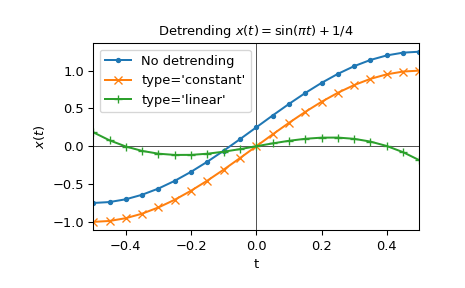detrend#
- scipy.signal.detrend(data, axis=-1, type='linear', bp=0, overwrite_data=False)[source]#
Remove linear or constant trend along axis from data.
- Parameters:
- dataarray_like
The input data.
- axisint, optional
The axis along which to detrend the data. By default this is the last axis (-1).
- type{‘linear’, ‘constant’}, optional
The type of detrending. If
type == 'linear'(default), the result of a linear least-squares fit to data is subtracted from data. Iftype == 'constant', only the mean of data is subtracted.- bparray_like of ints, optional
A sequence of break points. If given, an individual linear fit is performed for each part of data between two break points. Break points are specified as indices into data. This parameter only has an effect when
type == 'linear'.- overwrite_data: bool, optional
If True, allow in place detrending and avoid a copy. Default is False. In place modification applies only if
type == 'linear'and data is of the floating point dtypefloat32,float64,complex64orcomplex128.
- Returns:
- retndarray
The detrended input data.
See also
numpy.polynomial.polynomial.Polynomial.fitCreate least squares fit polynomial.
Notes
Detrending can be interpreted as subtracting a least squares fit polynomial: Setting the parameter type to ‘constant’ corresponds to fitting a zeroth degree polynomial, ‘linear’ to a first degree polynomial. Consult the example below.
Array API Standard Support
detrendhas experimental support for Python Array API Standard compatible backends in addition to NumPy. Please consider testing these features by setting an environment variableSCIPY_ARRAY_API=1and providing CuPy, PyTorch, JAX, or Dask arrays as array arguments. The following combinations of backend and device (or other capability) are supported.Library
CPU
GPU
NumPy
✅
n/a
CuPy
n/a
✅
PyTorch
✅
⛔
JAX
✅
✅
Dask
⚠️ computes graph
n/a
See Support for the array API standard for more information.
Examples
The following example detrends the function \(x(t) = \sin(\pi t) + 1/4\):
>>> import matplotlib.pyplot as plt >>> import numpy as np >>> from scipy.signal import detrend ... >>> t = np.linspace(-0.5, 0.5, 21) >>> x = np.sin(np.pi*t) + 1/4 ... >>> x_d_const = detrend(x, type='constant') >>> x_d_linear = detrend(x, type='linear') ... >>> fig1, ax1 = plt.subplots() >>> ax1.set_title(r"Detrending $x(t)=\sin(\pi t) + 1/4$") >>> ax1.set(xlabel="t", ylabel="$x(t)$", xlim=(t[0], t[-1])) >>> ax1.axhline(y=0, color='black', linewidth=.5) >>> ax1.axvline(x=0, color='black', linewidth=.5) >>> ax1.plot(t, x, 'C0.-', label="No detrending") >>> ax1.plot(t, x_d_const, 'C1x-', label="type='constant'") >>> ax1.plot(t, x_d_linear, 'C2+-', label="type='linear'") >>> ax1.legend() >>> plt.show()

Alternatively, NumPy’s
Polynomialcan be used for detrending as well:>>> pp0 = np.polynomial.Polynomial.fit(t, x, deg=0) # fit degree 0 polynomial >>> np.allclose(x_d_const, x - pp0(t)) # compare with constant detrend True >>> pp1 = np.polynomial.Polynomial.fit(t, x, deg=1) # fit degree 1 polynomial >>> np.allclose(x_d_linear, x - pp1(t)) # compare with linear detrend True
Note that
Polynomialalso allows fitting higher degree polynomials. Consult its documentation on how to extract the polynomial coefficients.